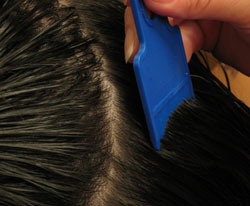 Has your child been infested with the dreaded headlice and their eggs (nits)?
Has your child been infested with the dreaded headlice and their eggs (nits)?
Don’t panic!
Getting rid of lice is not as traumatic as it may seem. And with the simple advice below I can help you rid your child’s scalp of those nasty parasites.
What Are Headlice?
A head louse is a tiny greyish brown parasite. Headlice cling to hair but are usually found on the scalp as they live on blood from your childs scalp. A headlice life cycle is about a month. The female lice will lay eggs (‘nits’) that can be found firmly attached to hair close to the scalp. The eggs look like sesame seeds and are difficult to remove.
Headlice do not jump or fly, they crawl from person to person. Headlice love clean or dirty hair, it is a myth that they only like dirty hair.
What Are The Symptoms?
Intense itching on the scalp and a rash may occur around the nape of the neck.
What To Look For?
I find the best way to look for headlice is to get the person to sit somewhere where you have plenty of light. I normally start searching behind the ears and the nape of the neck, sectioning the hair as you go along, searching the whole scalp. You will easily find the headlice and their eggs.
Remember when looking for headlice keep an eye out for a tiny, greyish brown insect and as for the eggs, small sesame seed like eggs that are very difficult to move.
Treatment For Head Lice
There are many products on the market for getting rid of lice – which can make choosing the right product very hard. Personally I’ve found the best headlice remedy to use when a child is infested is to avoid these products altogether.
Instead, simply wash and rinse your childs hair. Then lather their hair with conditioner and use a normal comb to work through the hair first, taking out any knots.
Then with conditioner still in the hair, switch to a proper headlice comb which has much finer teeth. Thoroughly comb through the hair section by section covering the whole scalp. With each stroke, check the comb for any living lice. If you find any, wash the comb out or wipe the comb on a piece of kitchen towel.
I then follow up with the next treatment 1 day later, and continue to do this until there are no signs of any parasites and eggs. I know this may sound time consuming but it is well worth the effort.
Keep in mind that you also have to wash hairbrushes using boiling water. I also recommend changing their pillow cases daily. There’s no need to go over board. But always keep vigilant.
Over my years of being a nanny I have found that headlice become immune to any chemical treatments that are on the market, so no method is 100% safe. But I use the simple method above and it has always worked wonders for getting rid of lice without using any nasty chemicals.
0 Comments